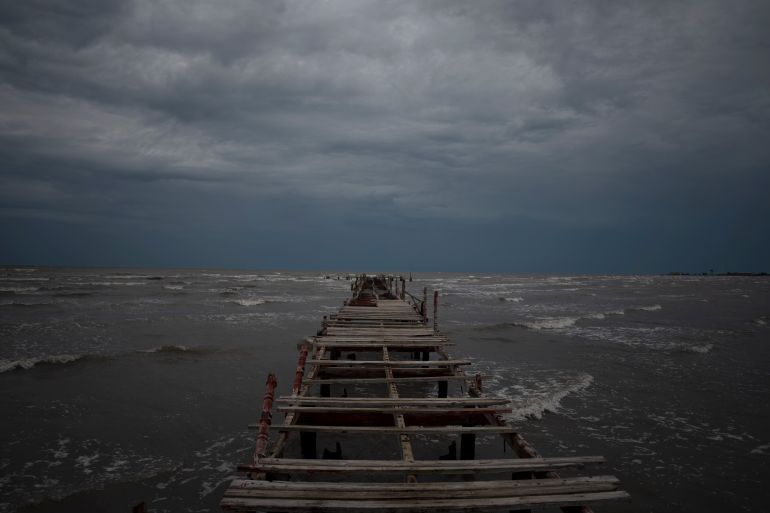Hurricane Ian strengthens as Cuba and Florida brace for impact
Authorities urge residents to heed evacuation orders as Hurricane Ian is expected to bring heavy rainfall and strong winds.

Hurricane Ian is growing stronger as it barrels towards western Cuba, where authorities have evacuated tens of thousands of people in preparation for heavy rainfall and “devastating” wind.
Ian was forecast to hit the western tip of Cuba on Monday evening as a major hurricane and then become an even stronger Category 4 with top winds of 225km per hour (140 miles per hour) over warm Gulf of Mexico waters before striking the US state of Florida later in the week.
Keep reading
list of 3 itemsCanada sends troops to help clear Hurricane Fiona’s devastation
Bermuda weathers Hurricane Fiona as storm moves towards Canada
Authorities have called on residents to make preparations in advance of the fast-moving storm, which the Miami-based National Hurricane Center (NHC) warned could bring “devastating wind damage” to western Cuba.
Cuban state media reported that authorities were evacuating 50,000 people in Pinar del Rio province, a more lightly populated part of the island dedicated primarily to farming and fishing – and where the storm is set for a direct hit.
They also sent in medical and emergency personnel, and took steps to protect food and other crops in warehouses.
“Cuba is expecting extreme hurricane-force winds, also life threatening storm surge and heavy rainfall,” NHC senior specialist Daniel Brown told The Associated Press early on Monday.
#Ian has strengthened into a hurricane and is expected to become a major hurricane as it moves through the Gulf. I encourage Floridians to ensure they are prepared and that their emergency supply kit is stocked with supplies.
Follow @FLSERT for updates. pic.twitter.com/emuw7fBzgJ
— Ron DeSantis (@GovRonDeSantis) September 26, 2022
Over the weekend, Cuba began evacuating tourists and some workers from Isla de la Juventud and Cayo Largo, off its southwestern coast, where the hurricane was expected to make landfall.
The country was shutting down its train system in advance of the worst weather, and officials have placed the island’s western provinces under a hurricane alert.
At a bakery in the Cuban capital, Havana, just after sunrise on Monday, the line for bread had swelled to nearly twice its normal length, occupying several blocks, as demand rose for basic goods before the storm.
Havana fishermen were taking their boats out of the water along the famous Malecon, the seaside boardwalk, and city workers were busy unclogging storm drains ahead of the expected rain. Resident Adyz Ladron, 35, said the potential for rising water from the storm worries him.
“I am very scared because my house gets completely flooded, with water up to here,” he said, pointing to his chest.
The Cayman Islands also had been bracing for the storm, with sandbags and plywood distributed to local communities.
But the centre of the hurricane passed to the west with no major damage reported on Monday, and residents were going back into the streets as the winds died down. “We seem to have dodged the bullet,” Grand Cayman resident Gary Hollins said. “I am a happy camper.”
In the Tampa Bay area of Florida, which could experience a surge of up to 2.4 metres (7.9 feet) of ocean water and 250mm (9.8 inches) of rain, residents lined up at stores to buy sandbags and bottles of water.
“Please treat this storm seriously. It’s the real deal. This is not a drill,” Hillsborough County Emergency Management Director Timothy Dudley said during a Monday news conference on storm preparations in the US city of Tampa, Florida.
Up to 300,000 people could be evacuated from areas in Hillsborough County, county administrator Bonnie Wise also said. Schools have been closed through Thursday and are expected to open as emergency shelters.
Florida Governor Ron DeSantis has declared a state of emergency throughout Florida, and US President Joe Biden also declared an emergency over the hurricane, freeing up additional government resources to provide assistance.
A hurricane watch has been issued for Florida’s central western coast, including the Tampa Bay area, and flash flooding is possible in the Florida Keys and the Florida peninsula through midweek.
Northern Florida could also experience heavy rainfall, along with the Florida panhandle and the southeast United States.
A forecast on Monday morning stated that Tampa and St Petersburg could experience the first direct hit by a major hurricane in a century.
Bob Gualtieri, sheriff of Pinellas County, Florida, which includes St Petersburg, said in a briefing that nobody would be forced out of their homes, even if evacuation orders were mandatory. But he warned that those who refused to heed the warning would be alone.
“What it means is, we’re not going to come help you. If you don’t do it, you’re on your own.”
St Petersburg Mayor Ken Welch also urged residents not to ignore any evacuation orders. “This is a very real threat that this storm poses to our community,” Welch said.
Hurricane Fiona rocked Puerto Rico, Bermuda and Canada last week, with winds up to 140kmph (87mph) slamming Puerto Rico and leaving the island without power.
Eastern Canada also experienced power outages as a result of the storm, and the Canadian military has been mobilised to assist with recovery efforts.